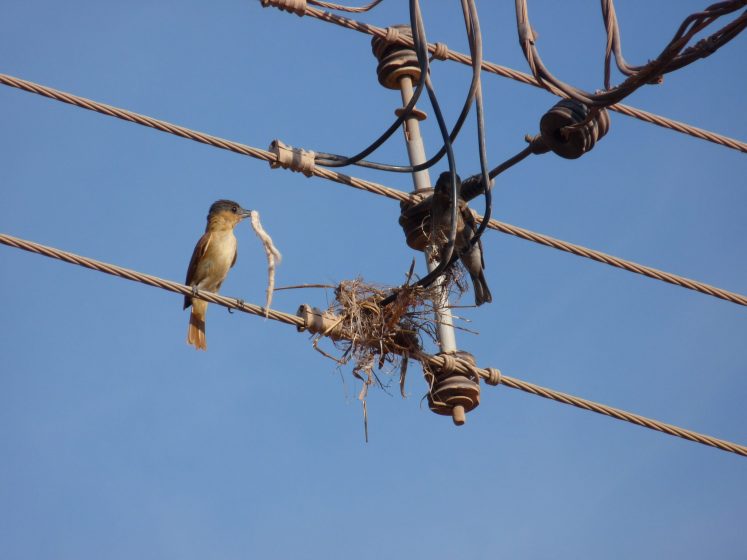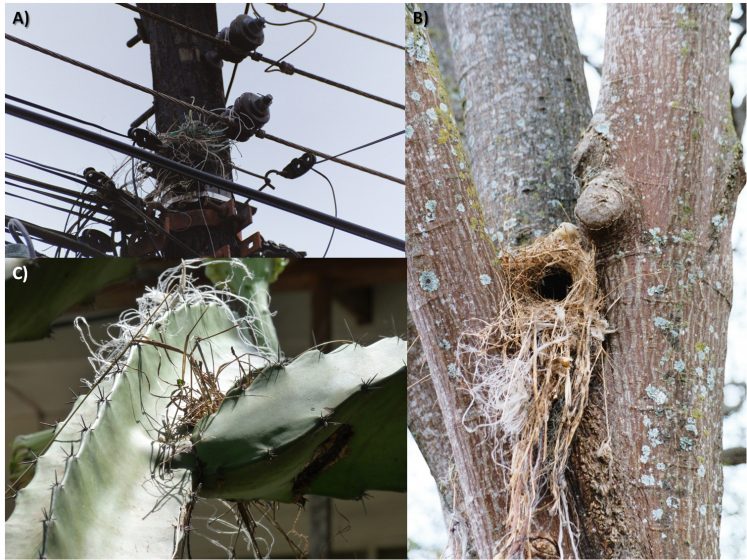Human activities have direct, negative consequences on almost all the world’s ecosystems. It is known that we are in a changing era in which uncontrolled human population growth and the associated increase of urban landscapes are leading to an alteration or reduction of natural areas. The activities that humans usually do, and the lack of understanding of the consequences related to these activities, has led to new interactions between humans and some species of animals that survive or colonize the city ecosystem.
Urban birds are using garbage as nesting material—but is this strategy beneficial or harmful to their survival?
Urban development imposes several constraints and produces direct impacts on such species’ “natural” habitats. One of the biggest impacts of urban development is the fragmentation and isolation of natural habitats, which limits the species’ movements between natural patches. Additionally, the isolation between natural habitats creates small islands, where just a limited number of individuals of each species may survive. Furthermore, these islands of natural habitats are surrounded and used by people, pets, and buildings; in some cases, they are crossed regularly by vehicles. This type of use in urban spaces and their surrounding habitats is the main driver of accumulations of different types of garbage inside or on the edges of what remains of undeveloped habitats.

Garbage is one of the consequences of human activity in urban areas. The type and quantity of these kinds of solid wastes are highly related to the level of income, level of development, and level of education in an area. For example, towns, cities, or countries with high proportions of low-income groups typically have inadequate infrastructure and garbage management services, increasing the amount of garbage around urban and “natural” areas. On the other hand, areas with high-income groups have reduced the amount of solid wastes around urban and natural areas; but even their garbage does not disappear completely.
Thus it is constantly argued that garbage availability imposes a risk for public health as well as to the environment because it contributes to the spread of diseases, to flooding, and to soil and air contamination. However, garbage is also used by different groups of animals, for example: as breeding places for vectors of human disease, as food by different type of pests (e.g., rodents) or as a new resource to include in the structures they build (e.g., squirrels, opossums, birds). How the use of garbage affects or benefits animals is poorly understand, because the diversity of waste types is high (e.g., plastic, wood, metal, polyester, and rubber), as are the forms in which each type of waste can be found in the environment (e.g., plastic bags, plastic ropes, pieces of plastic, or plastic mesh).
Despite all the negative effects that urban development produces on the natural environment, in cities, it is common to observe different groups of animals living and reproducing in what remains of “natural” habitats or within the city infrastructure. Those groups of animals are called urban species, as they can survive in the habitats modified by urbanization. Urban species may be classified as exploiters if they increase and occur in the area due to the urbanization, or survivors if they occur before urbanization takes place and continue to persist post-urbanization, but in lower numbers. Birds constitute one of the most common groups of urban animals; birds’ ability to fly allows them to move quickly between places to find refuge, food, or water inside cities. Additionally, several bird species are well adapted to urban areas because of their generalized diets (in other words, they can tolerate the majority of food resources available), large brains (allowing them to solve problems and use new resources), non-specific requirements for nesting places (can nest in the majority of available places), and small sizes (allowing larger populations to survive on small amounts of resources).

Although urban bird species may nest in the majority of available places in the cities, this group could face limitations to obtaining resources for nest building due to the small amount of natural areas where those materials occur. Therefore, some bird species are able to exchange natural materials for artificial ones usually found in urban areas (mainly, garbage) to incorporate as nesting material. For example, natural cotton materials obtained from plant seeds (e.g., bromeliads or Bombacaceae trees) or mosses may be exchanged with cotton insulation or polyester; some dry leaves may be exchanged with pieces of plastic bags, paper, or aluminum foil; and sticks may be exchanged with electric cables, plastic or natural ropes, or plastic sticks. Additionally, some other species of birds also add new and unusual materials to the nest, such as cigarettes butts or nails.
We consider the nest to be a structure built with two main objectives for birds (1) protection of the egg against potential danger and (2) temperature control that leads to adequate embryo development. We also consider that the nests we observe birds building now are the results of a long process of natural selection for the use of adequate materials to improve the rates of achievement of both objectives. It is possible that the use of new, artificial materials inside the nest would affect, in some way, one or both functions, negatively or positively. For example, one negative effect of the use of garbage for nest building could be an increase in the nest temperature when birds use plastic bags pieces, a situation that could negatively affect an egg’s embryo development. Another negative effect may be an increase in nest predation if, by being more conspicuos, artificial materials make nests more easily detectable by visual predators. It is also possible to expect a decrease in chicks’ survival because plastic or nylon ropes may attach and tangle around chicks in the nest, causing mortality. Conversely, a positive effect of the use of garbage could be a disruption of the nest image, because the use of new material may camouflage or blur the typical image of a nest, causing a decrease in nest detectability and, thereby, a reduction in predation by visual predators. Or, the use of some artificial materials may reduce the occurrence of parasites; for example, the nicotine present in cigarettes butts is known to work as a repellent against some hematophagous insects. Information about the direct consequences of garbage use as part of nest materials by birds is contradictory, and direct studies and experiments are lacking to understand whether these new behaviors are favoring the species that display them.
When thinking about the use of garbage as nesting material, it is important to remember that, within the same species (e.g., Clay-colored Thrush, Turdus grayi) in urban areas, some individuals use a lot of garbage as nesting materials, but others do not. This difference may be the result of the differences in garbage abundance around the nesting area, or differences in the abundance of the right materials for nesting. For example, the Clay-colored Thrush builds its nest with clay, mosses, and sticks in “natural” areas, but in cities, the availability of clay and mosses is reduced because the majority of soil is covered with concrete and humidity is reduced, lessening moss occurrence. Therefore, the lack of these materials for nest building may make an individual Clay-colored Thrush exchange mosses for some synthetic mosses/cotton-like materials common in garbage, such as pieces of plastic, cloth, or mesh that can be attached to the external nest structure in a similar way to mosses.

It may be that intrinsic differences between individuals influence the selection of the nesting material. It is also possible to find differences in nesting material selection between individuals that nest in areas with equal amounts and availability of garbage. Given the complexity of these patterns, it is hard to show a perfect relationship between garbage availability and the use of artificial materials as nesting materials. What we do know is that, obviously, it is impossible to use non-natural materials if they are not available. Therefore, the use of artificial materials could be related to urban landscapes where garbage is commonly available, but there is an interesting individual selection of materials for nesting that is poorly understood.
Although some urban bird species may be favoring the use of new materials in the nests, other materials could reduce their reproductive success. The reduction in abundance of natural materials for nest building is probably the force incentivizing species to use artificial materials, which are becoming more, not less, available as human activities increase. For now, for those groups which use garbage as nesting material, it is necessary to determine whether the garbage is a new adaptation that improves survival and breeding success in an urban world, or if it occurs solely as a result of the lack of natural materials in urban areas. If we find that the use of garbage for nesting materials is negative, we can start making management plans for solid waste that include the reduction of garbage and the provisioning of natural material for nest building. But, if the effect is positive on the species, a provisioning of some types of “garbage” could improve a strategy to preserve urban species that are adaptively using artificial materials for nesting.
Josué Corrales and Luis Sandoval
San José, Costa Rica
about the writer
Luis Sandoval
Luis Sandoval is a researcher and professor at Escuela de Biología, Universidad de Costa Rica. His research focuses on urban ecology, animal communication, and behavior and natural history of birds.







Leave a Reply